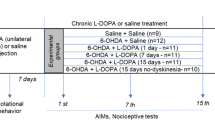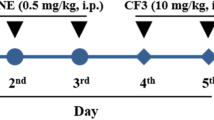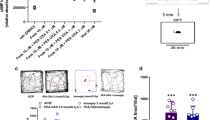Abstract
Parkinson’s disease (PD) patients, in addition to motor dysfunction, also present alterations in pain sensation. The present study characterized the antinociceptive effects of diphenyl diselenide ((PhSe)2) in a model of nociception induced by unilateral, intrastriatal 6-hydroxydopamine (6-OHDA) injection in rats. Male adult Wistar rats received 20 μg/3 μl of 6-OHDA (in saline solution containing 0.02 % of ascorbic acid) or 3 μl of vehicle into the right striatum (1.0 mm anterior, 3.0 mm lateral, and 5.0 mm ventral—with respect to the bregma). Thirty days after injection, rats received (PhSe)2 intragastrically at a dose of 10 mg/kg 1 h before behavioral tests (von Frey hairs, hot plate, tail immersion, formalin, and open field). Our results demonstrated that 6-OHDA injection to rats augmented the response frequency of von Frey hairs (VHF) stimulation, besides reducing the thermal withdrawal latency in the hot plate test. Importantly, the (PhSe)2 treatment decreased the mechanical allodynia measured by the response frequency of VHF stimulation and diminished the thermal nociception in the hot plate test in 6-OHDA-injected rats. In conclusion, these results revealed that a single oral administration of (PhSe)2 1 h prior to the accomplishment of the behavioral tests was effective to attenuate the increased mechanical and thermal nociception caused by a single intrastriatal 6-OHDA injection to rats. Furthermore, other clarifying studies are warranted to improve the evidence bases for future clinical use of (PhSe)2 as a new alternative therapy for the treatment of painful symptoms associated to PD.



Similar content being viewed by others
References
Blandini F, Nappi G, Tassorelli C, Martigno E (2000) Functional changes of the basal ganglia circuitry in Parkinson’s disease. Prog Neurobiol 62:63–88
Ford B (1998) Pain in Parkinson’s disease. Clin Neurosci 5:63–72
Giuffrida R, Vingerhoets FJ, Bogousslavsky J, Ghika J (2005) Pain in Parkinson’s disease. Rev Neurol (Paris) 161:407–418
Lee MA, Walker RW, Hildreth TJ, Prentice WM (2006) A survey of pain in idiopathic Parkinson’s disease. J Pain Symptom Manag 32:462–469
Mylius V, Engau I, Teepker M, Stiasny-Kolster K, Schepelmann K, Oertel WH, Lautenbacher S, Möller JC (2009) Pain sensitivity and descending inhibition of pain in Parkinson’s disease. J Neurol Neurosurg Psychiatry 80:24–28
Defazio G, Berardelli A, Fabbrini G, Martino D, Fincati E, Fiaschi A, Moretto G, Abbruzzese G, Marchese R, Bonuccelli U, Del Dotto P, Barone P, De Vivo E, Albanese A, Antonini A, Canesi M, Lopiano L, Zibetti M, Nappi G, Martignoni E, Lamberti P, Tinazzi M (2008) Pain as a nonmotor symptom of Parkinson disease: evidence from a case–control study. Arch Neurol 65(9):1191–1194
Brefel-Courbon C, Payoux P, Thalamas C, Ory F, Quelven I, Chollet F, Montastruc JL, Rascol O (2005) Effect of levodopa on pain threshold in Parkinson’s disease: a clinical and positron emission tomography study. Mov Disord 20(12):1557–1563
Ungerstedt U (1968) 6-Hydroxydopamine induced degeneration of central monoamine neurons. Eur J Pharmacol 5:107–110
Sauer H, Oertel WH (1994) Progressive degeneration of nigrostriatal dopamine neurons following intrastriatal terminal lesions with 6-hydroxydopamine: a combined retrograde tracing and immunocytochemical study in the rat. Neuroscience 59:401–415
Deumens R, Blokland A, Prickaerts J (2002) Modeling Parkinson’s disease in rats: an evaluation of 6-OHDA lesions of the nigrostriatal pathway. Exp Neurol 175:303–317
Chudler EH, Dong WK (1995) The role of the basal ganglia in nociception and pain. Pain 60:3–38
Prigol M, Brüning CA, Martini F, Nogueira CW (2012) Comparative excretion and tissue distribution of selenium in mice and rats following treatment with diphenyl diselenide. Biol Trace Elem Res 150:272–277. doi:10.1007/s12011-012-9464-z
Nogueira CW, Quinhones EB, Jung EAC, Zeni G, Rocha JBT (2003) Anti-inflammatory and antinociceptive activity of diphenyl diselenide. Inflamm Res 52:56–63
Zasso FB, Gonçales CE, Jung EA, Araldi D, Zeni G, Rocha JB, Nogueira CW (2005) On the mechanisms involved in antinociception induced by diphenyl diselenide. Environ Toxicol Pharmacol 19(2):283–289
Savegnago L, Pinto LG, Jesse CR, Alves D, Rocha JBT, Nogueira CW, Zeni G (2007) Antinociceptive properties of diphenyl diselenide: evidences for the mechanism of action. Eur J Pharmacol 555:129–138
Savegnago L, Jesse CR, Nogueira CW (2008) Caffeine and a selective adenosine A(2B) receptor antagonist but not imidazoline receptor antagonists modulate antinociception induced by diphenyl diselenide in mice. Neurosci Lett 436:120–123
Savegnago L, Jesse CR, Santos ARS, Rocha JBT, Nogueira CW (2008) Mechanisms involved in the antinociceptive effect caused by diphenyl diselenide in the formalin test. J Pharm Pharmacol 60:1679–1686
Paulmier C (1986) Selenoorganic functional groups. In: Paulmier C (ed) Selenium reagents and intermediates in organic synthesis, 1st edn. Pergamon, Oxford
Paxinos G, Watson C (1986) The rat brain in stereotaxic coordinates. Academic, San Diego
Greco R, Tassorelli C, Armentero MT, Sandrini G, Nappi G, Blandini F (2008) Role of central dopaminergic circuitry in pain processing and nitroglycerin-induced hyperalgesia. Brain Res 1238:215–223
Fang X, Sugiyama K, Akamine S, Namba H (2006) The stepping test and its learning process in different degrees of unilateral striatal lesions by 6-hydroxydopamine in rats. Neurosc Res 55:403–409
Nogueira CW, Zeni G, Rocha JBT (2004) Organoselenium and organotellurium compounds: toxicology and pharmacology. Chem Rev 104:6255–6286. doi:10.1021/cr0406559
Bortolanza LB, Ferreira J, Hess SC, Delle Monache F, Yunes RA, Calixto JB (2002) Anti-allodynic action of the tormentic acid, a triterpene isolated from plant, against neuropathic and inflammatory persistent pain in mice. Eur J Pharmacol 53:203–208
Woolfre HG, MacDonald AD (1944) The evaluation of the analgesic action of pethidine hydrochloride. J Pharmacol Exp Ther 80:300–307
Janssen PAJ, Niemegeers CJE, Dony JHG (1963) The inhibitory effect of fentanyl and other morphine-like analgesics on the warn water induced tail withdrawal reflex in rats. Arzeneimittelforschung 13:502–507
Pinardi G, Sierralta F, Miranda HF (2003) Atropine reverses the antinociception of nonsteroidal anti-inflammatory drugs in the tail-flick test of mice. Pharmacol Biochem Behav 74:603–608
Hunskaar S, Hole K (1987) The formalin test in mice: dissociation between inflammatory and non-inflammatory pain. Pain 30:103–114
Santos ARS, Calixto JB (1997) Further evidence for the involvement of tachykinin receptor subtypes in formalin and capsaicin models of pain in mice. Neuropeptides 37:381–389
Hall CS (1934) Emotional behavior in the rat: defecation and urination as measures of individual differences in emotionality. J Comp Psychol 18:385–403
Hall CS, Ballechey ELA (1932) A study of the rat’s behavior in a field: a contribution to method in comparative psychology. Univ Calif Publ Psychol 6:1–12
Walsh RN, Cummins RA (1976) Open-field test—critical review. Psychol Bull 83:482–504
Chaudhuri KR, Healy DG, Schapira AHV (2006) Non-motor symptoms of Parkinson’s disease: diagnosis and management. Lancet Neurol 5:235–245
Chudler EH, Sugiyama K, Dong WK (1995) Multisensory convergence and integration in the neostriatum and globus pallidus of the rat. Brain Res 674:33–45
Saade NE, Atweh SF, Bahuth NB, Jabbur SJ (1997) Augmentation of nociceptive reflexes and chronic differentiation pain by chemical lesions of either dopaminergic terminals or midbrain dopaminergic neurons. Brain Res 751:1–12
Chudler EH, Lu Y (2008) Nociceptive behavioral responses to chemical, thermal and mechanical stimulation after unilateral, intrastriatal administration of 6-hydroxydopamine. Brain Res 41–47
Fruhstorfer H, Gross W, Selbmann O (2001) Von Frey hairs: new materials for a new design. Eur J Pain Lond 5:341–342
Lambert GA, Mallos G, Zagami AS (2009) Von Frey’s hairs—a review of their technology and use—a novel automated von Frey device for improved testing for hyperalgesia. J Neurosc Meth 177:420–426
Jensen TS, Yaksh TL (1986) Examination of spinal monoamine receptors through which brainstem opiate-sensitive act in the rat. Brain Res 363:99–113
Savegnago L, Jesse CR, Moro AV, Borges VC, Santos FW, Rocha JBT, Nogueira CW (2006) Bis selenide alkene derivatives: a class of potential antioxidant and antinociceptive agents. Pharmacol Biochem Behav 83:221–229
Magnusson JE, Fisher K (2000) The involvement of dopamine in nociception: the role of D(1) and D(2) receptors in the dorsolateral striatum. Brain Res 855:260–266
Jesse CR, Rocha JBT, Nogueira CW, Savegnago L (2009) Further analysis of the antinociceptive action caused by p-methoxyl-diphenyl diselenide in mice. Pharmacol Biochem Behav 91(4):573–580
Savegnago L, Jesse CR, Pinto LG, Rocha JBT, Nogueira CW (2007) Diphenyl diselenide attenuates acute thermal hyperalgesia and persistent inflammatory and neuropathic pain behavior in mice. Brain Res 1175:54–59
Prigol M, Schumacher RF, Nogueira CW, Zeni G (2009) Convulsant effect of diphenyl diselenide in rats and mice and its relationship to plasma levels. Toxicol Lett 189:35–39
Acknowledgments
The financial support by the Universidade Federal de Santa Maria (UFSM), Coordenação de Aperfeiçoamento de Pessoal de Nível Superior (CAPES), Conselho Nacional de Desenvolvimento Científico e Tecnológico (CNPq), and Fundação de Amparo à Pesquisa do Estado do Rio Grande do Sul (FAPERGS-CNPq/PRONEX) research grant no. 10/0005-41 and FAPERGS research grant no. 10/0711-6 is gratefully acknowledged. C.W.N. is a recipient of a CNPq fellowship. J.T.R. is a recipient of FAPERGS/CAPES fellowship SPI Process no. 2793-25.51/12-4.
Author information
Authors and Affiliations
Corresponding author
Rights and permissions
About this article
Cite this article
da Rocha, J.T., Pinton, S., Gai, B.M. et al. Diphenyl Diselenide Reduces Mechanical and Thermal Nociceptive Behavioral Responses After Unilateral Intrastriatal Administration of 6-Hydroxydopamine in Rats. Biol Trace Elem Res 154, 372–378 (2013). https://doi.org/10.1007/s12011-013-9736-2
Received:
Accepted:
Published:
Issue Date:
DOI: https://doi.org/10.1007/s12011-013-9736-2




